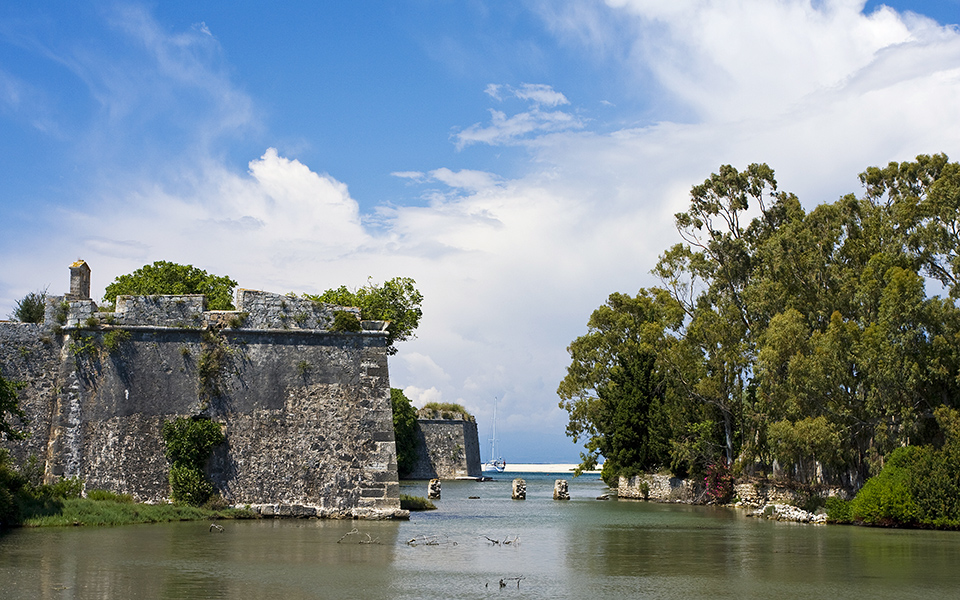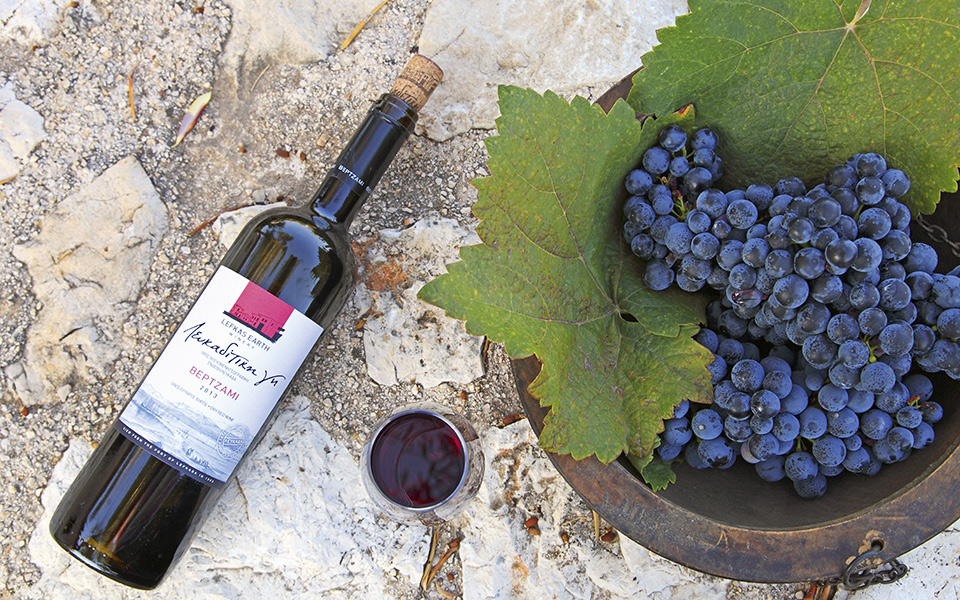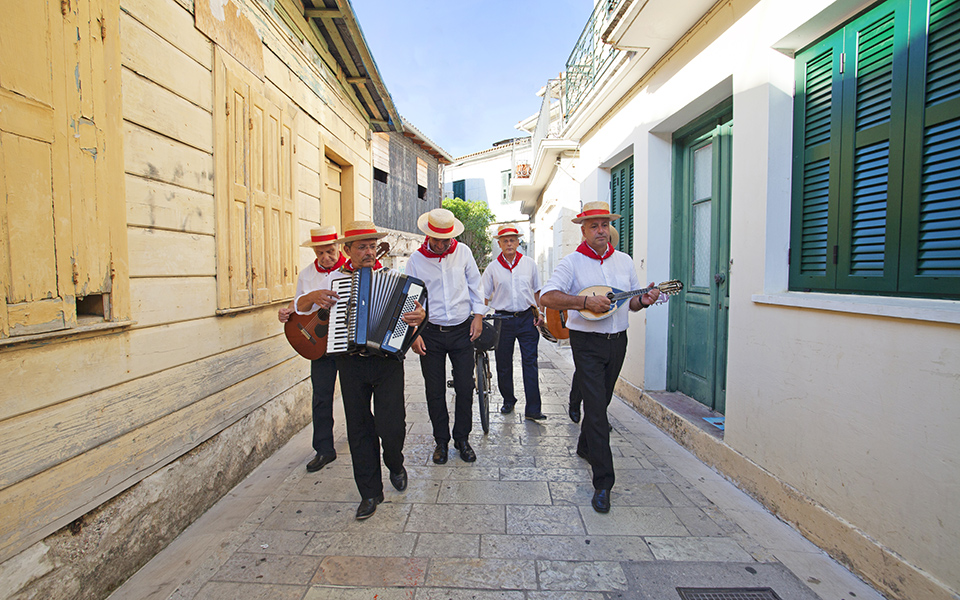Kimolos: A Summer Cinema Like No Other
A magical open-air cinema in Kimolos...

Egremni beach, one of Lefkada's most renowned beaches is bound to capture your imagination
© Olga Charami
Lefkada’s connection to the mainland by a long causeway and floating bridge serves as a major travel advantage since you don’t need a boat to reach it. This connection has influenced Lefkada both historically and culturally as the island’s traditions are a fusion of neighboring islands and the regional mainland.
The island’s wild and exotic character on the west side is counterbalanced by a serene east coast filled with delightful bays and islets. In contrast to the cosmopolitan beaches, the mountain villages are rustic and feature shady main squares. Visitors can enjoy a wide range of good food, from fresh fish to frigadeli (skewered liver wrapped in suet); listen to cantathes (traditional Italian-influenced serenades) as well as mainland folk music; discover gorges and deserted monasteries; legendary capes and world-renowned beaches; observe the main town’s unconventional use of corrugated iron as an exterior surface for upper levels of buildings; enjoy festivals and other cultural events; and leave with unique local products.

Riding the waves at Mylos beach
© Olga Charami
Words do not suffice to fully convey the breathtaking beauty of the island’s west coast – beaches of white sand, spectacular cliffs, turquoise waters and a mesmerizing Ionian Sea sunset. To reach Porto Katsiki and Egremni, the two most renowned beaches, you need to descend down 100 and 350 steps respectively. Pefkoulia; cosmopolitan Kathisma, livened up by a number of beach bars; Aghios Nikitas, graced by a developed yet traditional-looking village; isolated Mylos, requiring a 20-minute trek to reach; Gialos; Kavalikefta, located beyond Kalamitsi village; Megali Petra and Avali are all easier to access and equally attractive.
The Dimosari waterfall, whose waters cascade from a height of roughly 15 meters, is one of the island’s biggest surprises. It is located amid a gorge of the same name, above coastal Nydri, and can be reached after a 15 minute walk under plane trees, alongside the river and impressive rock formations. The waterfall’s flow is not as potent during the summer months, but the cold natural pool while forms below is always a temptation. The small café at the beginning of the trail is a bonus.
Windsurfers are drawn to Vassiliki’s Ponti beach in the island’s south, a spot renowned for its thermal winds, establishing it as one of the world’s top windsurfing locations. Kitesurfers head to Milos beach in the north, just beyond the main town, where the maistros northwesterly wind offers consistently perfect conditions. Competitive events are also staged on this beach, nowadays a world-renowned kitesurfing spot.

Paragliding is extremely popular at Kathisma beach
© Olga Charami
Paragliding at Kathisma beach on the west coast, is a thrilling experience that offers a bird’s eye view of the wider area. This activity, locally known as para pente, is extremely popular on Lefkada. Besides Kathisma, flights are also organized over Kalamitsi and Nydri. No experience is needed since escort pilots come as part of this breathtaking package. Photographs while in flight, are optional.
A lesser-known attraction, the Melissa gorge, located in the Sfakiotes area, immerses visitors into nature. Two trails have been developed within the gorge – a 30-minute walk towards Kako Lagadi and a 20-minute walk towards Apetasti. Even a pit-stop to wander into this environment for a few moments is worth it. Natural springs, small stone and wooden bridges, as well as about 50 water mills from the 19th century can be found here. The dense greenery, sound of water and birds combine for a captivating time.

Sailing boats dock in the bay in Nydri, a popular stop for seafarers
© Olga Charami
The western pier in the main town is a great place to be during sunset, producing a fiery red over the nearby Gyra lagoon. Waterside strollers and wooden fishing boats are reflected in the still waters of the western canal. The cobbled Aggelos Sikelianos esplanade is lined with ouzo and meze eateries and and cafes.
Rich greenery all the way down to the water, coves, inlets and islets grace the island’s eastern side. All types of vessels can be seen floating about in the wider area during the summer. The port at cosmopolitan Nydri and the large natural bay at nearby Vlyho are popular meeting points. Directly opposite Vlyho, the settlement of Geni is a well-kept secret. Tavernas set their tables on piers, perfect for the sailing community. The famed Prigiponisia group of islands – Madouri, Sparti, Skorpios and Skorpidi – as well as the small inhabited islands Meganisi, Kalamos and Kastos, all municipally associated with Lefkada, make for lovely excursions.

The view from Aghia (Santa) Mavra Castle is fascinating
© Olga Charami

Cape Lefkada with its lighthouse is a melancholy but breathtaking location
© Olga Charami
Located opposite the bridge before crossing over to Lefkada, this 14th century construction, developed by the Venetian Giovanni Orsini and duly utilized by the succession of powers – Ottomans, French, Russians, British and Italians – is a must-see. Large moats and powerful bastions have been preserved to this very day along with a 19th century lighthouse and the Aghia Mavra chapel, from which the island’s former name, Santa Mavra, was derived. The view is fascinating. The nearby Gyra lagoon and its endless stretches of sandy beaches seem to blur the boundaries between the island and the mainland.
Also known as Kavos Kiras, Niras and Doukato, Cape Lefkada is located at the island’s southernmost point. The lighthouse that stands here was built in 1890. The location’s pure white rocks inspired Lefkada’s name, meaning “whiteness” in Greek. A Homeric “white rock” reference and an ancient temple of Apollo are also linked to this location. According to legend, this cape is best known as the spot from which heartbroken souls, including the lyrical poet Sappho, jumped to their deaths into the churning sea below.

The main town carries the obvious influences of western-style architecture
© Olga Charami
The Panaghia (Virgin Mary) Faneromeni, the only fully functional monastery on the island, located above the main town, is the island’s protector and many locals choose to have their children baptized here. If interested in seeing some of the other somewhat abandoned monasteries, the three most elegant examples to be found are Kokkini Ekklisia (Red Church), close to Platystoma; Asomato Archangelo Michail in Vafkeri; and Ai-Giannis Sernikaris in Vournika. All three are reachable via dirt roads.
Brightly colored houses with corrugated iron exterior surfaces on their upper levels and stone-built ground levels, bougainvilleas, climbing plants and lanterns all grace the main town’s alleys. The iron-walled houses – developed as a protective measure against earthquakes – are a dominant main town feature, and create a delightful setting which captures the hearts of visitors. An initial Venetian town plan was updated by a British version intended to offer greater earthquake security, hence the tin walls. The town’s churches, built in the 17th and 18th centuries – Aghios Minas, Aghios Spiridonas, Aghios Nikolaos, Isodia Theotokou (Presentation of the Virgin) and Pantokratoras – were influenced by western architecture, while their icons inside carry Ionian Island influences. Enjoy a stroll along cobbled Mela street, visit the Phonograph Museum on a parallel back street, the archaeological museum and the impressive library featuring a collection of art from the Ionian islands.

The lentils of Egglouvi are famed for their taste - most of the 40 or so families based here are engaged in their cultivation
© Olga Charami
The local salami and renowned mandolato, a nougat bar with almonds, honey and meringue, are highly recommended local culinary stars. The island humid climate is ideal for producing salami, and the Italian-style recipe is said to have been introduced either by a traveler from Paxos or the Buranelli, natives of Burano, an island in the Venetian Lagoon. Local producer Delimaris, whose produce is also distributed beyond the island, makes some of the finest, but also look out for smaller producers. The mandolato nougat bars are said to owe their local existence to the island’s barbers, who produced them, along with pasteli sesame-and-honey bars, in the back rooms of their barber shops to pass the time between customers.
The lentils cultivated at the mountain village Egglouvi, at an altitude of 950 meters, are renowned for their particular taste, creamy texture and nutritional value. The seeds used are believed to have remained unaltered since 1717. Most of the 40 or so families based in Egglouvi are engaged in the cultivation of lentils – by hand and without the use of pesticides. Annual production amounts to approximately 50 tons and sells out quickly.
Lefkadian soumada is a drink made using bitter almond, sugar and rose water and served with coriander-flavored rusks, originally at happy occasions. Older folks used to make toasts by uttering the phrase: “Here’s to your soumades,” essentially a wish for happiness. The finest soumada is still served at Soldatos (aka Amerikanos) cafe in Kouzounteli, located slightly beyond the main town.
Also try the island’s renowned rozoli, a cinnamon-and-orange liqueur produced by the Fragoulis distillery since 1945. The liqueur’s recipe is believed to have been introduced to the island by the Venetians.

Lefkadian soumada is a drink made using bitter almond, sugar and rose water and served on happy occasions
© Olga Charami

Mandolato, nougat bars with almonds, are a speciality of the island
© Olga Charami

The Lefkaditiki Gi winery produces an award-winning vardea white, as well as two vertzami-based wines
© Olga Charami
Two special grape varieties, vertzami and vardea, cultivated exclusively on Lefkada, produce superb wines. The vertzami variety has dominated vineyards in Lefkada’s mountain range since Venetian times. It produces a potent red wine and may be tried either in bulk form at the villages or bottled at the island’s wineries. Worth visiting is the Lefkaditiki Gi winery, which produces an award-winning vardea white, as well as two vertzami-based wines, a red aged ibn the barrel for eight to 12 months, and a rosé. Their sweet Melidonos, a combination of sun-dried vertzami and patrino, is also special.
Three fishermen and one ichthyologist manage to keep the fish population balanced at the island’s natural fish farm in the Gyra lagoon, just beyond the main town. They describe the spot, a place of particular natural beauty, as a protected wetland. Controlled traditional fishing methods are used to preserve the location’s fish population. Mullet, eels, sea bream and seabass may be found in this natural fish farm’s shallow waters which only permit priari boats without keels. The fish corral themselves into wooden enclosures, where they are caught with fishing nets. Head to the municipal fish shop (dimotiko ichthyopolio) to sample some of the catch. Local roe, definitely worth trying, is also available here.
Lefkada is located 370 km from Athens along a route via the Rio-Antirrio bridge (120 euros return) and 380 km from Thessaloniki via the Egnatia Odos highway (90 euros return).

An unusual village dance during which women balance copper cooking pots on their heads in Karya village
© Olga Charami

Egglouvi village at an altitude of 950 meters represents an almost alpine side of the island
© Olga Charami
The age-old pezovolo fishing technique, still practiced in Lefkada, is locally known as syrti. A two-meter net, this contraption, shaped like an inverted cone with a lead weight at the bottom, is attached to a cane and sunk into the water, forming a cage. Live bait is then used to draw the catch. The technique is normally used in the autumn.
An impressive traditional women’s costume, a unique dance routine, as well as an rich embroidery tradition are key aspects of Karya, the island’s main mountain village. Silk and velvet dresses, scarves, gold chains and brooches are features of the traditional women’s costume. An unusual village dance during which women balance copper cooking pots on their heads, was conceived during the ‘50s by the dance instructor Nikos Thanos. Both the dance and the traditional costumes play key roles in Karya’s annual reenactment of the old village wedding ceremony, staged every August since 1979. At the local folk museum, fine embroideries are on display to demonstrate Karya’s signature embroidery stitch, a single-handed technique invented by local embroidery legend Maria Stavraka, whose physical disability prompted the idea. An embroidery school operated at this village in the early 20th century.

Cantadors, singing groups, comprised of professional and amateur musicians, have helped preserve the sound of serenades (cantades)
© Olga Charami
Lefkada boasts Greece’s second-oldest Philharmonic orchestra, established in 1850. In 1864 the ensemble performed at the historic ceremony held to mark the Ionian Islands’ handover by the UK to Greece, as well as at the first modern Olympics in Athens in 1896. Comprised of a large and small band, ensembles and a music school, the Philharmonic has 1,000 members as well as roughly 100 music students, helping keep the island’s vibrant artistic tradition alive. Today, they can be seen playing at religious processions, concerts and local feasts.
Sporting white shirts, red neckerchiefs and straw hats, cantadors, roam about the main town’s streets with mandolins, guitars and accordions. This singing group, comprised of professional and amateur musicians, has helped preserve the sound of serenades (cantades), believed to have been introduced to the island by the Venetians. In August, the barcarola event sees these musicians deliver their songs on a boat passing through the western canal.
A magical open-air cinema in Kimolos...
Experience Spetses in its most enchanting...
Discover Greece’s islands in September with...
From fishermen’s chants to moonlit serenades,...